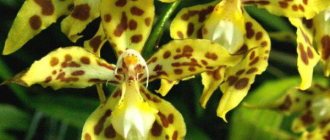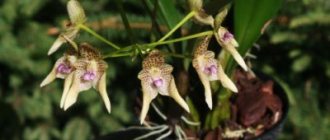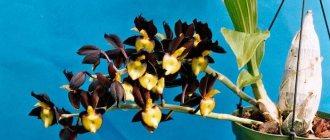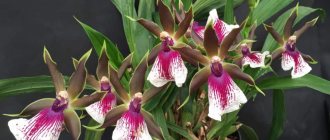Phalaenopsis, or butterfly orchids, get their name due to the shape of the flower, reminiscent of the open wings of a moth.
Phalaenopsis is native to the tropical rainforests of South India, the Philippines, and New Guinea. However, thanks to breeding work carried out since 1875, butterflies have firmly taken their place on windowsills and in the hearts of flower growers.
Kimono is a varietal orchid. Due to the variety of colors and decorativeness, the variety is very popular among orchidists all over the world.
Popular varieties
Of the huge number of varieties, we list the names of the most famous and original ones.
Black butterfly. A very beautiful and unusual phalaenopsis, the color of which, depending on the lighting, varies from rich dark burgundy with a chocolate tint to almost black.
The petals have a pointed shape, the one located in the core (lip) is white-yellow, with a burgundy edge. There are up to 8 flowers on the peduncle, reaching 5 cm.
Diamond King. It has bright burgundy flowers with a light border (diameter - 8 cm). The petalia closer to the center is white, with small leopard print patches, similar to freckles.
Manhattan. Currently, this hybrid is not registered, it only has a trade name. The flowers are soft pink or soft lilac, strewn with many small dotted burgundy inclusions, reminiscent of a marble pattern, with a bright orange or yellow center.
Pavarotti. The variety is known for its dense, almost monochromatic flowers of a rich wine shade. The diameter of the flowers is up to 8 cm.
Valencia. A rather rare variety of large phalaenopsis, growing up to 60 cm in height (including peduncle). The sepals and petals are snow-white, the lip is large, yellow inside and white outside. The center is deep burgundy, with an orange rim. Flowering period - up to 8 months.
Kimono. The color of the flowers is mottled purple, with a whitish-yellow border. The veins and tongue are darker, burgundy, the center is yellow-raspberry. They reach 7 cm in diameter.
Phalaenopsis has a huge variety of varieties
Legato. A hybrid with an unusual range of colors: on 2 peduncles reaching a height of up to 60 cm, flowers of soft pink, peach, golden-lilac pearl color appear twice a year and bloom for more than 8 weeks. Closer to the center, the silky petals have dark specks. The core is bright orange.
Separately, it is worth considering peloric orchids.
Pelorik is not a variety of orchid. This is the name given to plants that have non-standard bud shapes. Modification occurs as a result of mutation. Most often, petals grow together, as a result of which the bud does not open completely; sometimes different sepals or petals grow, taking the shape or shade of a lip.
A flower from monosymmetric (having 1 axis of symmetry) turns into radially symmetric, with several axes of symmetry.
Cascade
Cascade is not a separate variety or type of phalaenopsis, but simply the name of a plant whose peduncle shape has been artificially changed for greater beauty and aesthetics.
Distinctive features. External characteristics
- You have already seen some photos. Now this begs the question. So these are different varieties;
- And you were right. Phalaenopsis marked “Cascade” (look at the photo) is an artificially created direction of growth of the peduncle;
- And many flowers create a cascade.
Phalaenopsis Cascade is an artificially created direction of growth of the peduncle.
It is not difficult to buy such a Cascade. The price may be higher.
- But how to create it yourself? Here are just some tips: Use anything that can bend like that (vine, wire, plastic rods) as supports
- Try falikas with tall peduncles . In the growth stage. No branches;
- Mini ones don't fit.
By the way! Those who have become skilled at this even turn flowers. And the lighting is placed below for this.
Colors
This beauty is offered as a Cascade mix. Few people think about growth.
One writes correctly.
Colors of cascading phalaenopsis.
Cascade Mix.
This is Phalaenopsis Philadelphia.
Features of flowering
And they bloom and rest from flowering in the cascade in their own way. And yet there is one thing in common - very beautiful.
Subspecies
- Pink Dancer Cascade. Or Cascade Pink Dancer. Pink dancer! Or a dancer: With two peduncles. For 2000 rubles;
- Pink with small burgundy spots along the edges of the petals. Yellow-burgundy lip.
Cascade Pink Dancer.
Elegant Cascade.
- Purple flowers with white spots and edges.
Piano Kaskad.
Phalaenopsis WaterFall (Cascade).
- You may also remember the famous song “Waterfalls”.
For you, a video with an example of a transplanted cascading orchid:
Names of the best groups
Hybrids
Hybrids or mixes bring together a huge number of phalaenopsis of the most diverse, often unusual colors, which are bred both on the basis of varietal plants and as a result of crossing already obtained hybrids.
Here are some of them:
Anaconda
Anaconda. A flower up to 20 cm high with a delicate aroma and slightly rough leaf plates, along which vertical relief stripes run from the growing point to the end. The diameter of the flowers, which have a rich, bright yellow tint, does not exceed 6 cm. The surface of the petals is covered with a circular pattern of burgundy-colored specks, larger at the base, and the flower lip is also burgundy.
Mukalla
Mukalla. It has branching fleshy roots of a gray-green color and from 4 to 8 smooth green leaves of an asymmetrical oval shape, the length of which reaches 30 cm and the width is 10–12 cm.
The plant has from 1 to 4 peduncles 35–51 cm high. On them, medium-sized (4–5.5 cm) flowers with petals of a bright purple or lilac-violet hue and a red or dark red lip are located symmetrically on both sides. Flowers bloom sequentially, starting from the base, over 2–4 days.
Monaco
Monaco. Multifloral hybrid 45–55 cm high with sandy or grayish-brown petals, a white center and a yellow lip with a white tip. This orchid can have from 2 to 4 flower stalks.
Big Lip
Big lip, which means “big lips”. It got its name because of the large, unfolded, almost flat flower lip of a complex figured shape. This subspecies has several peduncles reaching a height of 70–80 cm, dense rich green leaves and large (up to 12 cm in diameter) flowers.
Golden
Phalaenopsis golden is a subspecies whose varieties are characterized by yellow shades of inflorescences, from lemon to golden. A plant with thick roots and large leaves blooms several times a year for two months, producing 2-3 flower stalks 75 cm tall. You can learn about popular varieties of golden phalaenopsis of the Golden group here.
Sogo
Sogo brings together varieties of phalaenopsis that belong to variegated plants, that is, those whose foliage is unevenly colored and is most often white-green, green-violet or green-red. The flowers of Sogo varieties are usually variegated, with stripes, specks or specks on a purple, white, yellow or lilac background, but monochromatic ones are also found.
Multiflora is a group of multi-flowered phalaenopsis hybrids with branching peduncles (up to 3 pieces) 60 cm high, producing up to 25 inflorescences. The leaves of representatives of this subspecies have a rich green color and reach a length of up to 35 cm. The adult plant itself looks like an airy flower bouquet. What colors does multiflora come in and how to care for it, read here.
Why is sakura a symbol of Japan?
Garden callas: photos with descriptions, care features, growing secrets and recommendations from gardeners
Sakura or Japanese cherry tree is one of the most famous symbols of Japan. When the Land of the Rising Sun is mentioned, the imagination necessarily evokes an association with a flowering ornamental plant of the plum subfamily, covered with a cloud of white and pink petals. The name "sakura" comes from the word "saku", which means "to bloom" and the plural ending "-ra". The ornamental plant blooms from late March to early April. During the remaining seasons, the trees are covered only with a crown of foliage, which falls off by winter.
The brief but magnificent season figuratively represents human life, when blossoming is inevitably followed by withering and death. The days of the spring equinox, when cherry trees bloom, are a time of religious holidays, which include rituals of requests for a good harvest. In this sense, the sakura flower is a symbol of prosperity and good luck.
Another symbolic meaning is to express the connection between people, representing various concepts such as courage, sadness and happiness. Cherry blossoms in Japanese culture are a manifestation of pure beauty. In addition, sakura is a metaphor for the fact that nothing lasts forever in this life. The theme of everything transitory, changing in the world, occupies a central place in the Buddhist religion.
The cherry blossom season coincides with the beginning of the Japanese Old New Year, which until 1873 was celebrated according to the lunar calendar and occurred at the beginning of spring. Hence, in the minds of the Japanese, there is a strong association with the beginning of something new, which is expected with enthusiasm and optimism. In different historical periods, the cherry blossom symbolized Japanese nationalism and militarism.
In Bushido, the code of the samurai, sakura was chosen as an emblem symbolizing the feat of a warrior who gave his life for the emperor. Samurai tattooed a cherry blossom as a reminder of the transience of life, when every day could be the last, so you should appreciate every moment and rejoice at any manifestation of beauty.
During World War II, these flowers were painted on kamikaze planes. Also in national aesthetics, sakura flowers represent the beauty and sexuality of a woman, her ability to control her emotions and dominate men. In the “language of flowers”, a sakura branch also means love and passion. Another meaning given to a delicate flower is innocence, simplicity and spring purity:
The color of the petals depends on the subspecies; there are white, pinkish and deep pink, scarlet, yellow, pale green shades. Japan hosts a spectacular national hanami festival in honor of the beloved tree. Relatives and friends gather for a picnic in cherry parks under the shade of fragrant branches, where they celebrate the beginning of the flowering season. The image of a sakura flower is used to decorate clothes (kimonos), letter paper, covers of notebooks and notepads, and household items, including kitchen utensils.
For centuries, cherry blossoms have inspired Japanese artists, who included cherry blossoms as landscape decorations in elegant prints. The cult of decorative cherries has been adapted in other cultures. In a number of countries, the tree is planted to decorate streets and parks. Since 1912, Washington DC has celebrated the Cherry Blossom Festival every year.
Phalaenopsis pink Legato
| Price | Quantity | |
| Pot diameter: 12cm Plant height: 55cm Dimensions: 1 flower stem | 1180 rub. | |
| Pot diameter: 12cm Plant height: 70cm Dimensions: 2 flower stems | 1680 rub. | |
| Pot diameter: 12/14cm Plant height: 85cm Dimensions: 2 colors. 3 flower stalks | 3680 rub. | To order |
Phalaenopsis Orchid
(Phalaenopsis) belongs to the orchid family. All countries of the Malay Archipelago can be called the birthplace of this beautiful indoor plant. Under natural conditions, the flower can be found in mountain forests in the Philippines and on the wet plains of Australia.
Care at home The main conditions for maintaining a plant are correctly selected air temperature and uniform lighting
Optimal temperature for a flower When maintaining this fairly hardy plant, it is very important to maintain the optimal temperature regime. During the day the temperature should be between 20-24 degrees
And at night it is advisable to reduce the temperature to 15-18 degrees. To do this, you can leave the window open all night in the room where the plant is located. If such conditions are not created for the flower, it will bloom much less often. Lighting Like many plants, indoor phalaenopsis orchids prefer soft, slightly diffused lighting. And, at the same time, they do not tolerate exposure to direct ultraviolet rays. It is best if the pot of phalaenopsis is placed on the eastern windowsill. In the hottest summer, the delicate orchid should be protected from the sun in order to protect the phalaenopsis leaves from dangerous burns. Watering Many novice gardeners, as a rule, do not know how to water phalaenopsis. The intensity of watering the plant directly depends on the air temperature. The hotter the room, the more often the phalaenopsis should be watered. And you definitely need to think about good drainage in the pot. Fertilizer To feed phalaenopsis, it is best to use ready-made mixtures prepared specifically for orchids. It is recommended to repot every two years because the roots of this plant develop best when the pot is fairly loose. In recent years, many gardeners have been placing phalaenopsis flowers in transparent plastic pots for constant monitoring of the plant's root system. Diseases and pests The main diseases of orchids are fusarium and gray rot, for the treatment of which any modern drug is suitable. It is also worth protecting the plant from spider mites and thrips, for the destruction of which intexicides are used. Winter care In winter, the plant should be dormant. It is also not advisable for the flower to bloom at this time. During the winter months, it is best to place it in a cool, shaded location, such as a north-facing window sill. How to make it bloom If an orchid does not bloom, then all you need to do is lower the room temperature to 16 degrees and reduce watering to once every 2-3 weeks. If you create the right conditions for the flower, it will bloom at least 2 times a year.
Humidity is of great importance for a flower. In summer, when it is especially hot and the air is too dry, the growth of the plant stops, the unopened buds dry out, and the leaves turn yellow. To increase humidity, it is better to place a flower pot on a tray filled with wet expanded clay or gravel. In addition, you can install a humidifier in the room. Unlike most house plants, phalaenopsis is not recommended to be sprayed in order to avoid leaf rotting.
Landing rules
In addition to observing the growing conditions, it is equally important to comply with the timing and technology of planting the butterfly orchid, and select the appropriate soil and container.
Priming
Flowers cannot be planted in regular soil.
In the wild, phalaenopsis grow on trees; they cannot be planted in regular soil.
You can buy a special soil for orchids in the store, which most often includes crushed bark and moss, or you can prepare the substrate yourself.
It is advisable to include:
- a large fraction of the bark of dry coniferous trees (for example, pine);
- peat moss (sphagnum);
- charcoal.
The bark should be free of resin and mold; before use, it must be boiled for about 3-4 hours.
It is best to take birch charcoal, having first crushed it to pieces approximately 2 cm in size. In the substrate, its amount should be about 5% of the total mass. Make sure that the soil used is loose and light.
Capacity
Orchid roots, like leaves, carry out photosynthesis, so it is advisable to choose transparent pots for them with drainage holes. This will allow the plants to receive the required amount of sunlight, and the owner of the flower to control the need for regular watering.
The ideal option would be a container with a special step at the bottom, 3 to 4 cm high, on which the plant is planted. The roots hang freely. To improve aeration, add a 2-3 cm layer of drainage to the bottom. These can be pieces of polystyrene foam, corks, coconut fiber, expanded clay.
Tip: during the flowering period, place the orchid pot in an opaque flowerpot. This will have a positive effect on her condition.
Timing and technology
The best time to purchase an orchid in a store is in the spring. At this time of year, it finishes flowering and begins the growing season.
If the center of the branches looks healthy - it does not have dried or rotted leaves, damaged, diseased roots, there is no need to replant it immediately, creating an unnecessary stressful situation for the plant.
The procedure is carried out only if the above-mentioned shortcomings are present, the pot size is too small, the soil is excessively compacted, etc.
Before planting, you should not water the orchid for several days for better removal from the container.
Standard planting technology:
- remove dead, dried roots, rotted leaves from the plant (yellowed leaves should not be removed, since they still contain a certain composition of nutrients; they can be removed later, after complete drying);
- powder the cut areas with charcoal;
- Place drainage material on the bottom of the pot in a layer of about 5 cm;
- Sprinkle the same layer on top with a substrate you prepared yourself or purchased at a specialty store;
- Place the flower in the center of the pot, placing a piece of foam plastic or coconut fiber under the rosette (try not to bury the root collar into the ground);
- sprinkle the roots with substrate, press down lightly;
- place the orchid in water for a short time;
- if the soil settles, add more substrate.
To support the peduncle during the flowering period, you can insert a support of a suitable size into the pot.
Nuances of choice
Floristry experts recommend buying orchids during their flowering period. Blooming flowers attract potential buyers with their appearance. Thanks to the special shape of the flower, customers do not pay attention to defects that would be worth checking. To get a healthy, strong flower for a long time, you need to check a lot.
- The roots of the plant must be firmly attached to the substrate. After hanging it in the planting container, there should be no signs of the plant deviating from its direction.
- Phalaenopsis leaves should have volume, impressive veins and strong outer tissue. The presence of shine on the leaves is an indicator of the health of the plant. And also it should not have dried ends or look limp.
- Phalaenopsis flowers should not show signs of rotting; bright color and reliable attachment of the inflorescence to the stalk are welcome.
Reproduction
The orchid has prepared for itself several ways to continue the race.
In nature, these are most often seeds or babies. The bud on the drying peduncle is placed in a familiar environment and grown.
Cuttings require constant care to maintain a certain humidity, degree of lighting and temperature conditions.
It is most effective to propagate by seeds or sprouts.
- The first method is more problematic and time-consuming, but it produces several plants, from which you can then select the strongest and most correctly formed ones.
- With a sprout there are fewer worries, but the risk of its death is greater.
Seeds
They are not able to grow in the usual conditions characteristic of other domestic flowers.
- The seeds must first be sterilized (planting them directly into the ground will destroy the seed).
- Then prepare a nutrient medium from a mixture of agar-agar and protofeed. The sowing itself is carried out over steam.
- For germination, glass containers with stoppers are used. The seeds are placed for 10 minutes in a calcium hypochlorite solution, after which they are pipetted onto a sterile nutrient medium.
- The containers are sealed with cotton swabs and transferred to a warm, well-lit place.
It will take almost a year for the seedlings to form normally. Then they are transferred to another nutrient base and raised again for 12 months.
Rostcom
Stem offspring develop on the mother's body for about six months.
When the peduncle grows 2-3 leaves and at least 2 pairs of roots (from 5 cm), you can remove the shoot from it along with a section of the stem
The shoot is also cut off from below, at the roots of the mother plant.
The cut areas are treated with crushed charcoal or cinnamon and dried for 2-3 hours.
The selected container is filled with wet substrate to 1/3 of the volume, a young shoot is placed inside and the substrate is added.
Prevention of diseases and pests
Infectious diseases rarely affect Phalaenopsis pelorica. They usually suffer from improper care. Direct sunlight can cause leaf scorch if the plant is placed on a windowsill on the south side of the house.
Orchids often suffer from excessive watering, the roots of the plant rot, and the green part dries out. Lack of lighting and keeping them in a cold room can also cause disease and death of the plant. A dense arrangement of orchids is not recommended; free air circulation is necessary for each plant. Periodically you need to ventilate the room, avoid allowing moisture to get on the buds when spraying. Irrigation of leaves is carried out in the first half of the day.
Sometimes pests are found on a plant sold in a store. In this case, the root system is completely separated from the soil in which the flower was sold. The plant is placed under water at room temperature and the roots are thoroughly washed.
Pelorics require high humidity in the room, but this can be easily achieved by placing a tray filled with damp pebbles or expanded clay next to the orchid. Creating comfortable conditions for keeping an orchid will protect the plant from various diseases.
Growing conditions
You can get spectacular and long-lasting flowering from this variety by following simple rules:
| Temperature _ | During the daytime +200 - +240, at night +150 -+180. |
| Air humidity | 50% – 70% |
| Attitude to light | Prefers good lighting, but does not like direct scorching rays of the sun. Tolerates light partial shade much better. |
| Aeration | Suffers from stagnation of air, prefers free movement of flow. At the same time, he is very afraid of drafts. |
Distinctive characteristics of an orchid with photo
Cleopatra is a well-known variety among orchid lovers. Botanical name: Phalaenopsis Cleopatra.
Features of the species are:
- a long flowering period is the main distinguishing feature;
- the rare color of the plant, which makes Cleopatra difficult to find in the store;
- the uniqueness of the colors of each bud, among which you cannot find 2 identical ones.
The flowers are different:
- colors;
- speckled shape;
- size.
Characteristics of the species:
- a plant with a monopodial growth pattern that develops upward;
- fleshy, oval leaf blades of large size, raised 45° relative to the stem;
- without the flower arrow, the height of the stem is 30 cm;
- An orchid often has 3–7 green leaves 10–30 cm long, collected in a rosette, from which flower stalks up to 70 cm grow;
- the crop has shortened internodes with two-row arrangement of leaves;
- roots are thick, long, greenish-pearl-colored, which absorb and retain moisture and participate in photosynthesis.
Orchids Wildcat and Cleopatra are often confused due to the external similarity of the buds. The differences are in the location of the spots. Wildcat has dense mottling that makes the flower appear purple from a distance.
Phalaenopsis Kimono butterfly.
Previous Entry | Next Entry
my_orchids As I have already written several times, for me to want to buy a phalaenopsis now, it must be a peloric or a butterfly. A butterfly is preferable. It’s sad that orchid sellers inflate prices sky high for such specimens. Although I suspect that they are purchased in bulk. How else can we explain that in non-specialized stores such as supermarkets, rare colors and butterfly pelorics (if, of course, they happen to be found there) are sold at the same price as regular ones? Anyway. Just in a regular store where I came for cottage cheese and cream, and at a fairly affordable price, I bought my new butterfly. Meet Phalaenopsis Kimono: And on different backgrounds:
By the way! Happy Valentine's Day! (how good it is that I bought this orchid 2 weeks ago, and not on the eve of the holidays, when flowers are as expensive as an airplane)
Tags:
my-orchids.livejournal.com
Care
The plant needs to be fertilized
The plant feels good in a complex substrate. But calcium, nitrogen and phosphorus run out there very quickly, and their additional addition is required. They can be obtained from organic, mineral and complex fertilizers.
The frequency of feeding is once every 30 days.
Fertilizer
| Name | Frequency | View | Proportions | Way | Effect |
| Fertika Crystalon | Once every 30 days | mineral | 0.5 g per 10 liters of water | basal | Replenishment of minerals |
| Sugar | 1 time per week | mineral | 1 teaspoon per 1 liter of water | when watering | Replenishes energy, strengthens weak plants |
| Bona Forte | 1 time per month | comprehensive | 1 g per 0.5 l of water | basal | Strengthens the immune system, replenishes the deficiency of nutrients |
| Tonic with succinic acid | 1 time every 2 weeks | comprehensive | In finished form | spraying, wiping leaves | Slows down the aging process, increases resistance to disease. |
Watering
You should carefully study the characteristics of the variety, and then choose the optimal method of moisturizing. This can be a spill, partial submersion of the substrate, a shower or a water cushion.
The frequency is determined independently
You need to pay attention to the condition of the roots: when they turn light silver, this is a signal for hydration
Usually in summer the procedure is carried out every 3-4 days, in winter much less often - after 10-15 days.
Transfer
It is carried out no more than once every 2 years when the nutrient substrate is depleted after flowering, in the spring. If the baby begins to form, the transplant is postponed for six months.
After removing the plant from its previous habitat, it is left to rest overnight, the roots are inspected, and rotten or dead ones are removed. In the morning they are planted in a new substrate.
Pests and their control
The home orchid has practically no parasites; the substrate is carefully processed. However, citrus and mealybugs may be present. They can be easily removed with a soft cloth soaked in a solution of laundry soap.
Diseases and treatment
The most common diseases are fusarium, anthracnose and gray mold. The fight is carried out symptomatically, using spraying with preparations containing copper.
Prevention
To monitor the health of the plant, regular visual inspection is carried out, an optimal humidity level is maintained, and excessive accumulation of water in the rosettes of leaves is eliminated.
Features of flowering
Phalaenopsis begins to bloom at the age of 2.5 - 3 years.
It can be difficult to recognize the beginning of the process - on the stem, in addition to the peduncle, adventitious roots can form. They can be distinguished by the following characteristics:
- the peduncle has a pointed tip, scales appear in the embryonic stage.
- the adventitious root has a blunt tip, the surface is smooth, without scales.
On some plants, buds appear almost simultaneously (this is most often found in pink species). In others (white species), the lower buds open first, then the upper ones, as a result of which the flowers on the orchid are present for a longer time.
Stimulating flowering
The more the daytime temperature differs from the night temperature, the faster the phalaenopsis blooms. In addition, flowering can be stimulated by a stressful situation:
- Stop watering for 10 days;
- then lower the pot into warm water for a quarter of an hour;
- after which they feed.
Recommendations
The frequency and volume of fertilizing must be reduced.
If roots begin to protrude from the drainage holes and look diseased or damaged, or the soil becomes compact and dries out quickly after watering, you may want to repot.
Pruning after flowering
Only completely dried flower stalks need to be trimmed.
The flower stalks of the plant dry out after flowering. They must be removed and the cut area covered with wax or plasticine.
If only the top has dried, cut off only the dried part. Buds may still appear on it.











